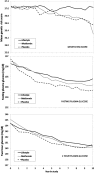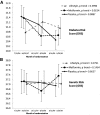Factors affecting the decline in incidence of diabetes in the Diabetes Prevention Program Outcomes Study (DPPOS)
- PMID: 25277389
- PMCID: PMC4338587
- DOI: 10.2337/db14-0333
Factors affecting the decline in incidence of diabetes in the Diabetes Prevention Program Outcomes Study (DPPOS)
Abstract
During the first 7 years of the Diabetes Prevention Program Outcomes Study (DPPOS), diabetes incidence rates, when compared with the Diabetes Prevention Program (DPP), decreased in the placebo (-42%) and metformin (-25%), groups compared with the rates in the intensive lifestyle intervention (+31%) group. Participants in the placebo and metformin groups were offered group intensive lifestyle intervention prior to entering the DPPOS. The following two hypotheses were explored to explain the rate differences: "effective intervention" (changes in weight and other factors due to intensive lifestyle intervention) and "exhaustion of susceptible" (changes in mean genetic and diabetes risk scores). No combination of behavioral risk factors (weight, physical activity, diet, smoking, and antidepressant or statin use) explained the lower DPPOS rates of diabetes progression in the placebo and metformin groups, whereas weight gain was the factor associated with higher rates of progression in the intensive lifestyle intervention group. Different patterns in the average genetic risk score over time were consistent with exhaustion of susceptibles. Results were consistent with exhaustion of susceptibles for the change in incidence rates, but not the availability of intensive lifestyle intervention to all persons before the beginning of the DPPOS. Thus, effective intervention did not explain the lower diabetes rates in the DPPOS among subjects in the placebo and metformin groups compared with those in the DPP.
Trial registration: ClinicalTrials.gov NCT00004992 NCT00038727.
© 2015 by the American Diabetes Association. Readers may use this article as long as the work is properly cited, the use is educational and not for profit, and the work is not altered.
Figures




References
-
- American Diabetes Association Report of the Expert Committee on the Diagnosis and Classification of Diabetes Mellitus. Diabetes Care 1997;20:1183–1197 - PubMed
Publication types
MeSH terms
Substances
Associated data
Grants and funding
LinkOut - more resources
Full Text Sources
Other Literature Sources
Medical

